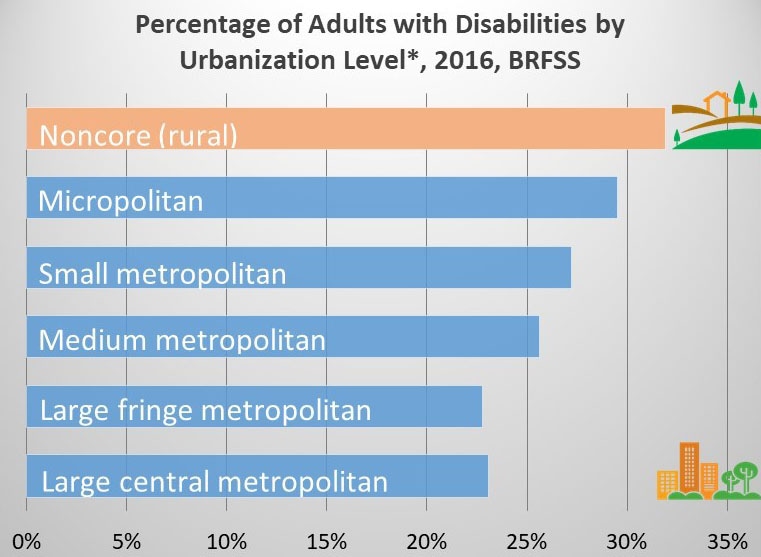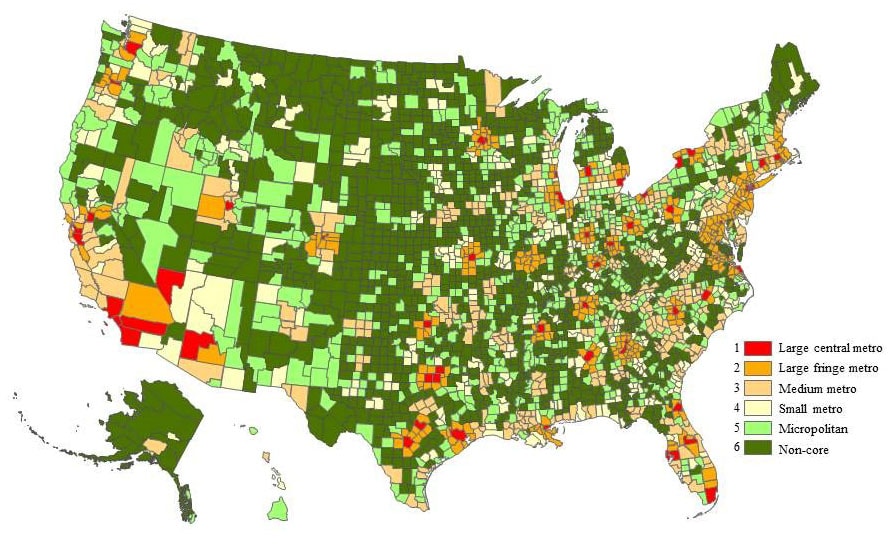Prevalence of Disability and Disability Types by Urban-Rural County Classification – United States, 2016

*2013 NCHS Urban–Rural Classification Scheme for Counties1
About One in Three Adults in Rural Communities Lives with a Disability
The American Journal of Preventive Medicine published a new report comparing the percentage of adults with disabilities living in urban versus rural U.S counties. By analyzing self-reported data from the 2016 Behavioral Risk Factor Surveillance System (BRFSS) across six levels of urbanization, (i.e. noncore (rural); micropolitan; and small, medium, large fringe, and large central metropolitan counties) CDC researchers were able to estimate
- The percentages of adults with any disability, and by disability type (hearing, vision, cognition, mobility, self-care, and independent living), and
- The percentages of adults having one, two, or three or more disabilities.
Researchers found that the percentage of adults living with disability was highest in noncore (rural) counties and lowest in large central and fringe metropolitan (urban) counties. Compared with adults living in large central metropolitan counties, adults living in noncore counties were
- 9% more likely to report having any disability;
- 24% more likely to report having three or more disabilities; and
- More likely to report specific disability types (ranging from 7% more likely to report a cognitive disability to 35% more likely to report a hearing disability).
These findings serve as reminders that people with disabilities live in all geographic areas. It is important that public health programs include people with disabilities living in rural communities.
Read a summary of the article »external icon
Main Findings
- About one-third of adults in rural communities lives with a disability.
- One in twelve adults in rural counties reports having three or more disabilities.
- The percentage of adults with disabilities increased with decreasing population size, from large metropolitan counties to noncore counties, in almost all sociodemographic subgroups, except for older adults (65 years and older) and Hispanics.
About This Study

*2013 NCHS Urban–Rural Classification Scheme for Counties1
CDC researchers analyzed data on adults with disabilities for counties categorized according to the 2013 NCHS Urban–Rural Classification Scheme for Counties.1 From most urban to most rural, these categories include
- Large central and large fringe metropolitan counties (together including ≥1 million residents);
- Medium metropolitan counties (250,000-999,999 residents);
- Small metropolitan (≥ 50,000 residents) counties;
- Micropolitan (10,000–49,999 residents) counties; and
- Noncore (i.e., rural) counties.
Nearly 19% of noncore counties in this study are in the Southern and Midwest regions of the United States, compared to 3.1% in the West coast region, 2.9% in the Northeast, and 6.7% nationally.
BRFSS allows respondents to self-report on up to six functional types of disability. Specifically, participants were classified as having one of the six disability types if they answered “yes” to the following questions:
- “Are you deaf or do you have serious difficulty hearing?” (hearing disability);
- “Are you blind or do you have serious difficulty seeing even when wearing glasses?” (vision disability);
- “Because of a physical, mental, or emotional condition, do you have serious difficulty concentrating, remembering, or making a decision?” (cognitive disability);
- “Do you have serious difficulty walking or climbing stairs?” (mobility disability);
- “Do you have difficulty dressing or bathing?” (self-care disability); and
- “Because of a physical, mental, or emotional condition, do you have difficulty doing errands alone such as visiting a doctor’s office or shopping?” (independent living disability).
Respondents who answered ‘yes’ to at least one of the disability questions were classified as having “any disability.”
Implications
- Approximately one in four adults (25.7%) in the United States, or 61 million people, reports living with at least one disability. Women, older adults (≥ 65 years), American Indians/Alaska Natives, adults with lower income, and adults living in the South are more likely to have a disability.2 However, few studies have looked at the percentage of disability and disability types by urbanization level overall and among specific populations. Knowing which disabilities are most common in which groups and where people with disabilities live can help inform public health interventions that aim to reduce health disparities.
- According to this study, the prevalence of adults with a disability in the United States is significantly higher in rural areas compared to large metropolitan areas. These findings, along with a recent study showing that the percentage of adults having at least four of five health-related behaviors (sufficient sleep, current nonsmoking, nondrinking or moderate drinking, maintaining a healthy body weight, and meeting aerobic physical activity recommendations) was lowest in noncore counties,3 indicates the need for rural public health interventions to be inclusive of people with disabilities.
- Compared with adults with disabilities living in urban areas, those in rural areas may face additional barriers (e.g., lower socioeconomic position, transportation problems, access to education and vocational rehabilitation services, access to health care and accessible communities)4 to maintaining and improving their health, quality of life, and community participation. Making rural communities disability inclusive and accessible can potentially improve the health and well-being of this population.
CDC Work to Improve the Health of People with Disabilities
CDC supports 19 state disability and health programs and two National Centers on Health Promotion for People with Disabilities, all of which promote healthy lifestyles and work to improve quality of life for people with disabilities. The primary goals of the state programs are to
- Improve knowledge and awareness about the usefulness and effectiveness of programs, policies, systems, and environmental changes for people with select functional disability types (e.g., mobility and/or intellectual disabilities); and
- Support programs in planning, implementing, evaluating, and disseminating non-research activities aimed at promoting inclusion and accessibility and reducing health disparities between people with or without disabilities.
CDC’s Disability and Health website also provides information and resources to increase awareness about disability inclusion, helping to ensure that every individual, with or without disabilities, can live, work, learn, and play in their communities.
We encourage you to visit the Disability and Health website to find helpful information about disability inclusion and learn more about
- Barriers that keep people with disabilities from participating in their communities;
- Strategies to create inclusive communities; and
- Resources for inclusion of individuals with disabilities in public health programs and activities.
CDC also maintains the newly updated Disability and Health Data System (DHDS), an online interactive tool that provides instant access to state-level, disability-specific health data. Users can customize the disability and health data they view, making it easy to find data on adults with and without disabilities and by functional disability type.
More Information
Key Findings Reference
Zhao, Guixiang et al. Prevalence of Disability and Disability Types by Urban–Rural County Classification—U.S., 2016
American Journal of Preventive Medicine, Volume 57, Issue 6, 749 – 756
Additional References
- Ingram DD, Franco SJ. 2013 NCHS Urban–Rural Classification Scheme for Counties. Vital Health Stat. 2014; 2 (166):1‒73. Available at /nchs/data/series/sr_02/sr02_166.pdfpdf icon.
- Okoro CA, Hollis ND, Cyrus AC, Griffin-Blake S. Prevalence of Disabilities and Health Care Access by Disability Status and Type Among Adults — United States, 2016. MMWR Morb Mortal Wkly Rep. 2018; 67 (32):882–887. Available at https://www.ncbi.nlm.nih.gov/pmc/articles/PMC6095650/external icon.
- Matthews KA, Croft JB, Liu Y, Lu H, Kanny D, Wheaton AG, et al. Health-Related Behaviors by Urban-Rural County Classification – United States, 2013. MMWR Surveill Summ. 2017; 66 (5):1-8. Available at https://www.ncbi.nlm.nih.gov/pmc/articles/PMC5829834/external icon.
- Sage R, Ward B, Myers A, Ravesloot C. Transitory and Enduring Disability Among Urban and Rural People. J Rural Health. 2019; 35 (4):460-470. Available at https://doi.org/10.1111/jrh.12338external icon.
